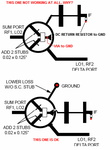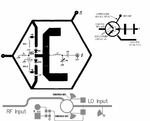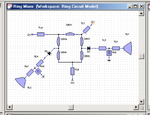Terminator3
Advanced Member level 3
Below is the image that explains my question:

As you can see, instead of taking IF from the point where diode pair is connected, i take IF from high impedance line that was connected to GND before. DC return is identical, but reversed in position. Unfortunately that does not work and i can't understand why. It is totally silence on the IF output. Although i thought it must be possible, because similar mixers exist:
(TYPE 1)

But on this images separate diodes are used. But i still can't understand why using single-case diode pair can stop mixer from working in my setup?
Here is more traditional rat-race mixers:
(TYPE 2)

So all i wanted is to use TYPE 1 arrangement but use diode pair in single case.
I checked my mixer by cutting traces, and when i come back to TYPE 2 configuration it starts to work. I am confused what is the problem here.
I taken images from:
1. Agilent EEsof EDA "The 2001 CAD Benchmark Rat-Race mixer characterisation"
2. SMS7630-061: Surface Mount, 0201 Zero Bias Silicon Schottky Detector Diode data sheet
3. Low Cost Mixer for the 10.7 to 12.8 GHz Direct Broadcast Satellite Market (application note 1136)
4. https://www.qsl.net/yo4hfu/Files/TG/RAT RACE 1296 mixer.pdf (rat-race mixer by WA6UAM H.Paul Shuch)
5. https://lsedr.weebly.com/rf-mixer--mezcladores-de-rf.html (rat-race mixer)

As you can see, instead of taking IF from the point where diode pair is connected, i take IF from high impedance line that was connected to GND before. DC return is identical, but reversed in position. Unfortunately that does not work and i can't understand why. It is totally silence on the IF output. Although i thought it must be possible, because similar mixers exist:
(TYPE 1)

But on this images separate diodes are used. But i still can't understand why using single-case diode pair can stop mixer from working in my setup?
Here is more traditional rat-race mixers:
(TYPE 2)

So all i wanted is to use TYPE 1 arrangement but use diode pair in single case.
I checked my mixer by cutting traces, and when i come back to TYPE 2 configuration it starts to work. I am confused what is the problem here.
I taken images from:
1. Agilent EEsof EDA "The 2001 CAD Benchmark Rat-Race mixer characterisation"
2. SMS7630-061: Surface Mount, 0201 Zero Bias Silicon Schottky Detector Diode data sheet
3. Low Cost Mixer for the 10.7 to 12.8 GHz Direct Broadcast Satellite Market (application note 1136)
4. https://www.qsl.net/yo4hfu/Files/TG/RAT RACE 1296 mixer.pdf (rat-race mixer by WA6UAM H.Paul Shuch)
5. https://lsedr.weebly.com/rf-mixer--mezcladores-de-rf.html (rat-race mixer)
